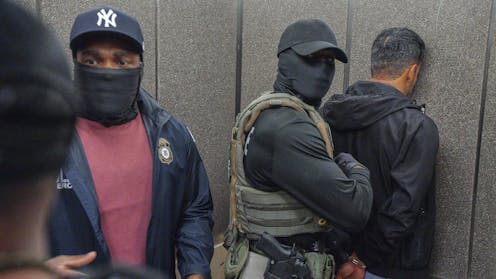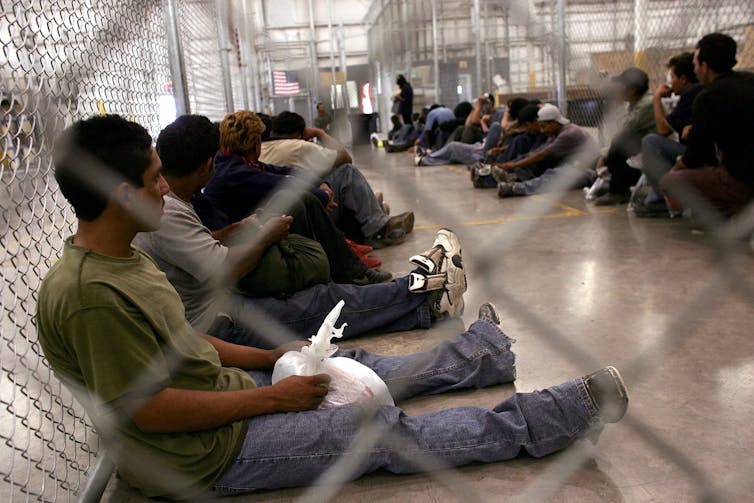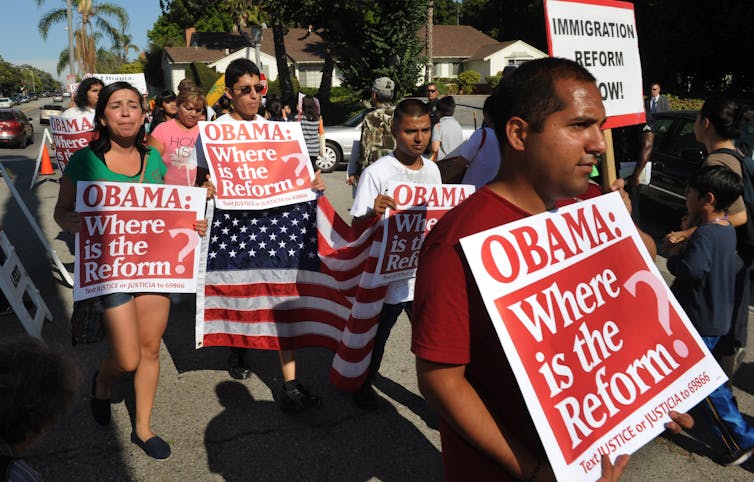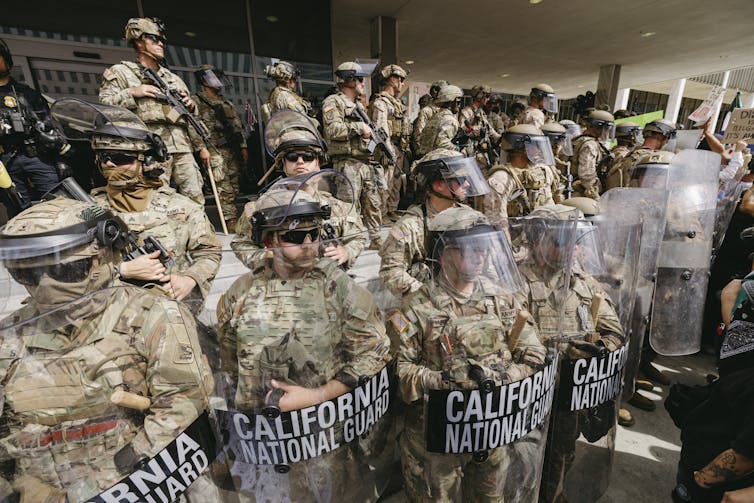Deportation tactics from 4 US presidents have done little to reduce the undocumented immigrant popul
After his predecessors failed to diminish the US population of undocumented immigrants, President Trump is attempting to drastically reduce that population via unprecedented tactics.

All modern U.S. presidents, both Republican and Democratic, have attempted to reduce the population of millions of undocumented immigrants. But their various strategies have not had significant results, with the population hovering around 11 million from 2005 to 2022.
President Donald Trump seeks to change that.
With harsh rhetoric that has sowed fear in immigrant communities, and policies that ignore immigrants’ due process rights, Trump has pursued deportation tactics that differ dramatically from those of any other modern U.S. president.
As a scholar who examines the history of U.S. immigration law and enforcement, I believe that it remains far from clear whether the Trump White House will significantly reduce the undocumented population. But even if the administration’s efforts fail, the fear and damage to the U.S. immigrant community will remain.
Presidents Bush and Obama
To increase deportations, in 2006 President George W. Bush began using workplace raids. Among these sweeps was the then-largest immigration workplace operation in U.S. history at a meat processing plant in Postville, Iowa in 2008.
U.S. Immigration and Customs Enforcement deployed 900 agents in Postville and arrested 398 employees, 98% of whom were Latino. They were chained together and arraigned in groups of 10 for felony criminal charges of aggravated identity theft, document fraud and use of stolen Social Security numbers. Some 300 were convicted, and 297 of them served jail sentences before being deported.

In 2008, Bush also initiated Secure Communities, a policy that sought to deport noncitizens – both lawful permanent residents as well as undocumented immigrants – who had been arrested for crimes. Some 2 million immigrants were deported during Bush’s two terms in office.
The Obama administration limited Secure Communities to focus on the removal of noncitizens convicted of felonies. It deported a record 400,000 noncitizens in fiscal year 2013, which led detractors to refer to President Barack Obama as the “Deporter in Chief.”
Obama also targeted recent entrants and national security threats and pursued criminal prosecutions for illegal reentry to the U.S. Almost all of these policies built on Bush’s, although Obama virtually abandoned workplace raids.
Despite these enforcement measures, Obama also initiated Deferred Action for Childhood Arrivals, or DACA, in 2012. The policy provided relief from deportation and gave work authorization to more than 500,000 undocumented immigrants who came to the United States as children.
Obama deported about 3 million noncitizens, but the size of the undocumented population did not decrease dramatically.
The first Trump administration and Biden
Trump’s first administration broke new immigration enforcement ground in several ways.
He began his presidency by issuing what was called a “Muslim ban” to restrict the entry into the U.S. of noncitizens from predominantly Muslim nations.
Early in Trump’s first administration, federal agents expanded immigration operations to include raids at courthouses, which previously had been off-limits.
In 2017, Trump tried to rescind DACA, but the Supreme Court rejected Trump’s effort in 2020.
In 2019, Trump implemented the Remain in Mexico policy that for the first time forced noncitizens who came to the U.S. border seeking asylum to wait in Mexico while their claims were being decided. He also invoked Title 42 in 2020 to close U.S. borders during the COVID-19 pandemic.
Trump succeeded in reducing legal immigration numbers during his first term. However, there is no evidence that his enforcement policies reduced the size of the overall undocumented population.
President Joe Biden sought to relax – although not abandon – some immigration enforcement measures implemented during Trump’s first term.
His administration slowed construction of the border wall championed by Trump. Biden also stopped workplace raids in 2021, and in 2023, he ended Title 42.
In 2023, Biden sought to respond to migration surges in a measured fashion, by temporarily closing ports of entry and increasing arrests.
In attempting to enforce the borders, his administration at times pursued tough measures. Biden continued deportation efforts directed at criminal noncitizens. Immigrant rights groups criticized his administration when armed Border Patrol officers on horseback were videotaped chasing Haitian migrants on the U.S.-Mexico border.
As of 2022, the middle of the Biden’s term, an estimated 11 million undocumented immigrants lived in the U.S.

A second chance
Since his second inauguration, Trump has pursued a mass deportation campaign through executive orders that are unprecedented in their scope.
In January 2025, he announced an expanded, expedited removal process for any noncitizen apprehended anywhere in the country – not just the border region, as had been U.S. practice since 1996.
In March, Trump issued a presidential proclamation to deport Venezuelan nationals who were members of the Tren de Aragua gang, designated a foreign terrorist organization by the State Department. In doing so, he invoked the Alien Enemies Act of 1798 – an act used three times in U.S. history during declared wars that empowers presidents to remove foreign nationals from countries at war with the U.S.
Declaring an “invasion” of migrants into the U.S. in June, Trump deployed the military to assist in immigration enforcement in Los Angeles.
Trump also sought to dramatically upend birthright citizenship, the Constitutional provision that guarantees citizenship to any person born in the U.S. He issued an executive order in January that would bar citizenship to people born in the U.S. to undocumented parents.

The birthright executive order has been challenged in federal court and is mostly likely working its way up to the Supreme Court.
Under the second Trump administration, immigration arrests are up, but actual deportation numbers are in flux.
ICE in June arrested the most people in a month in at least five years, roughly 30,000 immigrants. But deportations of noncitizens – roughly 18,000 – lagged behind those during the Obama administration’s record-setting year of 2013 in which more than 400,000 noncitizens were deported.
The gap between arrests and deportations shows the challenges the Trump administration faces in making good on his promised mass deportation campaign.
Undocumented immigrants often come to the U.S. to work or seek safety from natural disasters and mass violence.
These issues have not been seriously addressed by any modern U.S. president. Until it is, we can expect the undocumented population to remain in the millions.
Kevin Johnson does not work for, consult, own shares in or receive funding from any company or organization that would benefit from this article, and has disclosed no relevant affiliations beyond their academic appointment.
Read These Next
Midlife weight gain can start long before menopause – but you can take steps early on to help your b
What you do in the years leading up to menopause can help counter the natural hormonal effects of aging,…
Who thinks Republicans will suffer in the 2026 midterms? Republican members of Congress
The president’s party almost always loses seats in the midterms. More than two dozen Republican House…
How to reduce gift-giving stress with your kids – a child psychologist’s tips for making magic and a
Depending on family circumstances and a child’s personality type, gift giving runs the gamut of fun…






